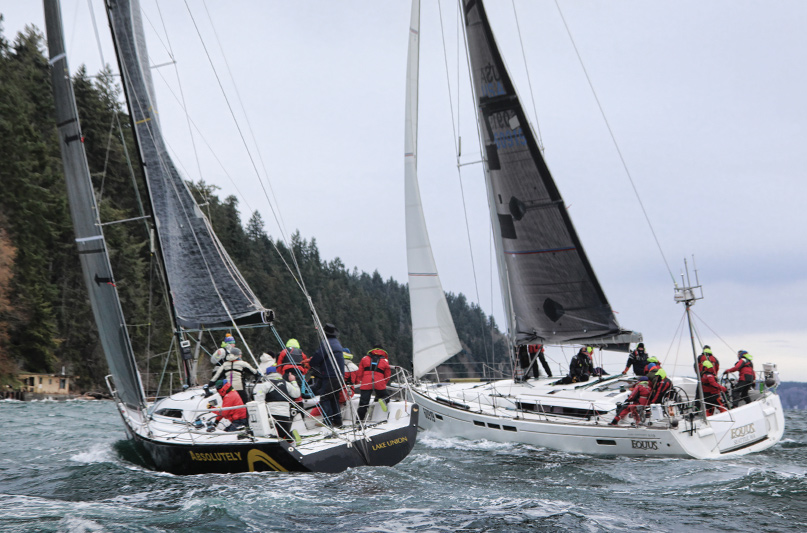The Gig Harbor Yacht Club Islands Race, the last race of the winter South Sound Series, takes its name from the historical course rather than any island. Back in the proper olden days, before the time of smart phones and electric cars, the racecourse was truer to its namesake. Racers would head south through the Tacoma Narrows, around a rotating cast of islands or temporary marks, and then head back to finish near the east end of Fox Island to avoid fighting the heavy currents in the Tacoma Narrows for a second time.
Eventually, it was decided to change things around in hopes of creating a more consistent race and have the fleet racing in the dragstrip of Colvos Passage. The race in its current guise takes the fleet from Gig Harbor northward through Colvos Passage, around a mark set just north of Blake Island, and then back to the finish in Gig Harbor. This year, I was lucky enough to be onboard Absolutely with a dialed-in group of racers, who have put more than a couple miles on the logbook together.

Personally, I love GHYC Islands race and find it one of the most dynamic racecourses in Puget Sound with its swirling one-way currents in the narrow Colvos channel. Strong northerly winds in the low 20s met the fleet at the start line, and things got underway with a bit of excitement off the line as the boats worked their way out along the shoreline, calling for room to tack against the beach. Eventually, the boats settled into the upwind beat through Colvos.
Crews worked hard to stay on their feet and work their way through the choppy waves and gusty breeze that made finding the balance between power and twist critical for trimmers throughout the day. Nearing the north end of Vashon, the waves began to stack up over the shallow water and things got a little sporty as we tacked amongst the heavy chop, resulting in a couple of very aggressive slams. Getting out in the favorable current was well worth the few minutes of discomfort. Rounding the windward buoy, we promptly hoisted our kite and got the boat rolling along downwind in the steady 20-knot winds.
The wind held as we settled into a gybing duel against our rivals onboard Jam, our competitors for the series’ first place in the PHRF-2 class. Midway through the run, we were swarmed suddenly by a pod of orca whales, which forced us to gybe a bit earlier than we had hoped, but well worth staying out of the way of the real masters of the Salish Sea. Things got sporty again nearing Gig Harbor, a heavy current flowing out of the narrows made for slow going and a game of chicken with the shoreline to get out of the negative water. We were able to hold off Jam after a series of gybes into the finish and took home line honors and class win for the series. Not a bad way to wrap up a cold winter of racing.
While it was a fantastic day on the water for those of us that raced, it was a week later that we realized just how significant those few hours of sailing had been. With the spread of COVID-19, the racing calendar would come to a screeching halt. Especially difficult is losing the local regattas that draw an international crowd, including such favorites as Southern Straits Classic and the Swiftsure 2020 race. The trickle-down effect resulted in the cancellations of many of the Hawaiian races that included these overnight races as part of their entry requirements.

Outside of the Northwest, it’s global AP over A (the flag that indicates that a race is being postponed on shore) as professional, Olympic and local athletes are doing what they can to stay active and engaged in the sport they love, albeit alone. As many of the domestic Olympic qualifying regattas have already been sailed, the U.S. team is fairly well established and so far no racers are in danger of losing their spots. It’s anyone’s guess as to when things are going to get back on track. Even players at the top end of the sport are taking measures to limit the spread of the virus. The wild hydro-foiling machines of the Americas Cup and Sail GP remain in their climate-controlled sheds with upcoming events are cancelled in the wake of travel restrictions and social distancing requirements.
Meanwhile, at nearly every level of the sport, everyone from sail lofts to TP52 Super Series teams are actively building personal protection equipment (PPE) for local medical centers, using their manufacturing capabilities to help the people on the frontlines fighting this virus. Amidst it all, a silver lining has emerged for racers in the form of an abundance of opportunities to learn new skills.
Many of the best sailors in the world have been actively sharing their knowledge online through podcasts and webinars. They are a fantastic opportunity and will expand anyone’s understanding or even refresh the mind of a seasoned racer. Sailmakers, navigators, boat builders, and riggers are all posting and hosting daily web seminars to help racers improve their boats and racing skills during this forced break.
Looking forward, we are seeing many of the large European and North American dinghy regattas and world championships rescheduled for this upcoming fall, and there are high hopes that things will get back on track as we move into summer. With plenty of time to work on projects, it’s time to look to the future and be ready as soon as the global postponement flag drops.


